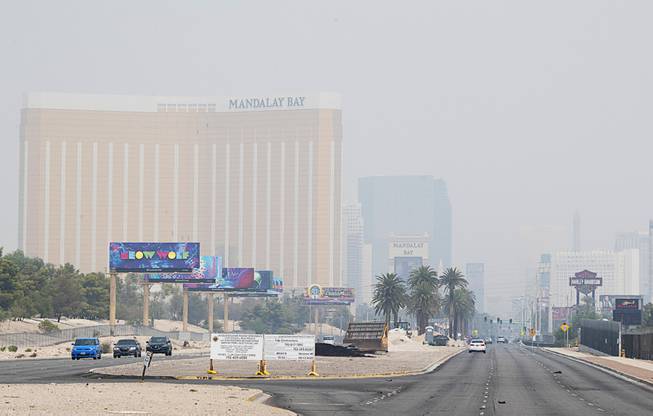
Smoke from California wildfires obscures the view of Strip casinos in Las Vegas Saturday, Aug. 7, 2021. The Clark County Department of Environment and Sustainability has issued an alert for smoke and ozone due to the wildfire smoke.
Tuesday, April 11, 2023 | 2 a.m.
Air quality in Las Vegas
Wildfires, vehicle pollution and high temperatures this summer could generate enough ozone gas to sicken children, elderly people and anyone with respiratory or cardiac conditions while inducing wheezing and coughing in the relatively healthy, according to Clark County officials.
“Clark County, because of geography, topography and climate, is a perfect oven to cook ozone,” said Kevin MacDonald, public information administrator for the Clark County Department of Sustainability.
That’s why the county is again issuing a dual warning for ozone gas and wildfire smoke spanning from April 1 to Sept. 30.
Ozone gas forms when pollutants from vehicles and industry, dust particulates in the air and wildfire smoke that contain volatile organic compounds and nitrogen oxides combine under strong sunlight and hot conditions.
Paul Fransioli, a senior meteorologist with the division of air quality, said Clark County’s low elevation compared to the surrounding mountains means those gases tend to stay trapped, sloshing around like water in a bathtub, until wind from the mountains disperses them. Without Clark County’s nigh-inescapable winds, the pollutants stay put.
“It’s not conducive to the best air quality,” he said.
Clay Morgan, a senior forecaster with the local National Weather Service office in Las Vegas, said the service’s Climate Prediction Center hadn’t reported any indicators of whether April, May and June in Clark County would be above or below their average temperatures, but this season is projected to be slightly drier than last year.
“It’s important to remember that’s a very dry period anyway,” Morgan said. “So, one rainstorm, and that’s out the window.”
He said last year, precipitation was down during those months. The sole rainfalls in that timeframe — on April 22, June 22 and June 28 — only produced what meteorologists call a “trace” of precipitation, less than 100th of an inch each.
“It’s just enough to mess up a car wash,” he said.
MacDonald said of the past six summers, five brought wildfire smoke that contributed to ozone formation. Last summer didn’t generate much ozone gas, he said, thanks to cloud cover and wetter conditions than usual in July, August and September.
“We’ve had a couple of really bad seasons where you go outside and you can’t see the mountains for days, and that does contribute to ozone formation,” MacDonald said. “But then once it blocks the sun, we have another problem with particulate matter.”
Fransioli said pollutants of all kinds could blow in from Southern California and as far away as China.
“We have a lot of homegrown ozone too,” MacDonald said. “You’re going to have that when you have 1.4 million vehicles all in one place.”
There are 13 ozone sensors scattered throughout Clark County. If any of them detect that the surrounding air is more than 70 parts per billion ozone gas for at least an eight-hour period, the county has exceeded EPA air quality standards. The county experienced 14 “exceedance” days last year, compared with 28 days in 2021.
Fransioli said sensors in the western part of the valley typically flagged higher ozone levels and more exceedance days compared with the rest.
“That has to do with airflow dynamics,” he said. “There are stations that are more susceptible.”
MacDonald said exceedance days have been trending downward overall for the past 20 years thanks to vehicle regulations, but wildfires have caused spikes in the past five.
Dust storms can also launch enough particulates into the air to cause an ozone spike, but dust has been less of a problem thanks to a concentrated effort to regulate construction in the 1990s, he said.
“We can do everything within our power here in Clark County to keep air pollution down as much as possible through regulatory work, monitoring complaints and all that, and still have something that happens hundreds of miles away that we have no control over,” MacDonald said. “It rolls in and completely engulfs us.”
The division recommends staying inside during elevated ozone days, keeping doors and windows closed in favor of filtering air through air conditioning, limiting strenuous outdoor exercises and reserving most outdoor activities for morning or evening.
